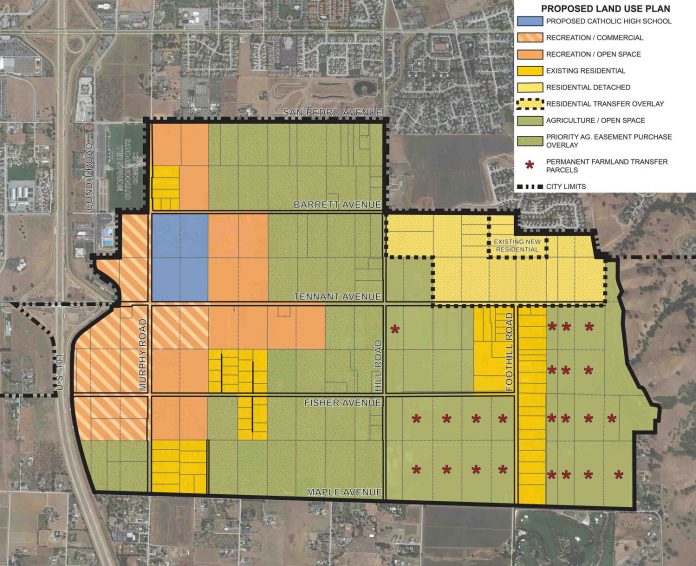
What will become of nearly 1,200 acres of prime farmland in the Southeast Quadrant now that the Santa Clara County Local Agency Formation Commission has denied the City of Morgan Hill’s request to annex a portion of the property?
There are both long-term and short-term answers to that question. The city’s plan was to expand its Urban Service Area around 229 acres and turn it into a Sports-Recreation-Leisure district, using developer fees and existing local open space funds to purchase permanent agricultural easements on other farmland elsewhere in the SEQ .
But LAFCO shot down that plan March 11.
County authorities, environmental nonprofits and the Santa Clara Valley Open Space Authority are working on a regional ag preservation framework, which is expected to be complete in 2017. At that time, the county can compete for a share of $40 million available statewide through cap-and-trade funds, but that funding isn’t guaranteed. This is the long-term goal.
The county recently received a $100,000 “Sustainable Agricultural Lands Conservation” grant to draft this framework.
Committee For Green Foothills Environmental Advocate Julie Hutcheson said despite the anticipated fierce competition for the cap-and-trade funds, the fact that Santa Clara is one of only three counties in the state to receive the SALC grant is a good omen.
“This is what we’ve been saying for years: step back and take a look at this from another perspective,” Hutcheson said of the city’s and county’s competing ag preservation proposals following the March 11 meeting. “The county is very serious about protecting the agricultural resources in this part of the county. Their involvement may help secure funding in purchasing agricultural easements. It’s a very hopeful process.”
In the meantime, without any restrictions on the SEQ farmland, most of it can be developed into five- to ten-acre residential lots, under current county zoning. The most recent occurrence of this possibility is seen on Trail Drive, where five “McMansion” estates—in the parlance of some members of the public who spoke at the March 11 meeting—are under construction on roughly five-acre lots each.
“We feel good that we set the bar pretty high; we’re the only city in the county that has (an agricultural preservation) program,” said developer Gordon Jacoby, a longtime proponent of the city’s SEQ ag preservation plan and SRL district. However, he added that SEQ property owners might not wait for the county’s ag plan without any guarantees, since they are “getting older” and not as interested in farming as they used to be.
Jacoby sold a 22-acre agricultural parcel in the SEQ to the City of Morgan Hill last year for about $5.3 million. The city intends to one day build baseball and softball fields on the site. The sales contract with the city allows Jacoby to retain a portion of the site for a future commercial development.
David Puliafico and his family own a 38-acre site on Tennant Avenue, which is also tagged in the city’s proposed SRL district for future sports fields. Puliafico said at the March 11 LAFCO meeting that his family has farmed the property in the past, but they don’t now and they never will.
“We could have sold this property for five McMansions years ago,” Puliafico told the commission. “We believe in the city’s plan, for thousands of children to come play on our land. This is prime spot for the kids to come.”
Angelo Grestoni of Top Flight Sports Academy said he left the March 11 meeting “really upset” about LAFCO’s decision. He owns a nearly four-acre parcel near the intersection of Tennant Avenue and Condit Road, where he hopes to one day build an indoor basketball facility.
His gripes had as much to do with the procedural aspect of the meeting as the merits of the commission’s decision, which also nixed plans by the San Jose Diocese—at least temporarily—to build a new private Catholic high school in the SEQ.
“They didn’t take any time to understand the city’s position,” Grestoni said. “Here’s a perfect opportunity by the city to do something to enhance sports for the youth and bring in a Catholic high school. That has to be valuable for a community.”
Don Hordness, a longtime farmer and owner of Royal Oaks Mushrooms on Watsonville Road, was at the rejected end of a second annexation request, by a narrow 4-3 vote, at the March 11 LAFCO meeting. Hordness took exception to the idea that the OSA is going to run any future agricultural easements in the area, rather than experienced farmers.
“The Open Space Authority has no farmers on their board. This is within the City of Morgan Hill’s sphere of influence, and they need to be the ones that control this land,” Hordness said. “The future of ag in the county has got to be with the people who are working the land.”







